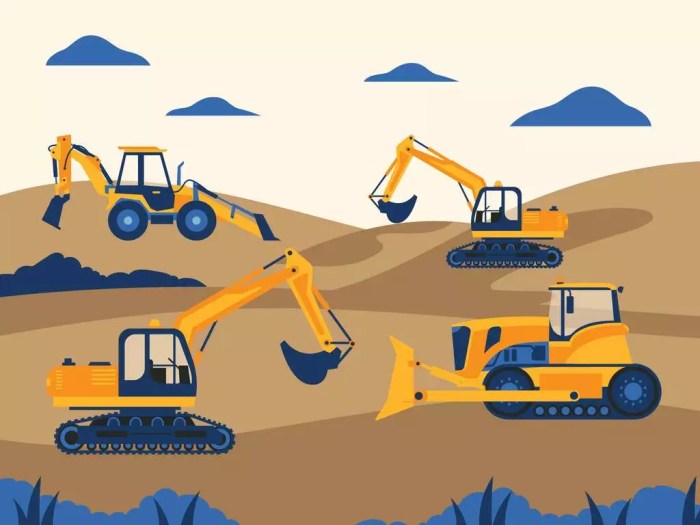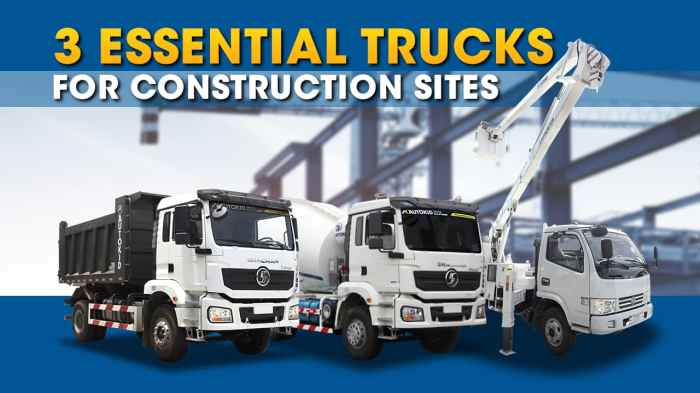Important features of construction trucks play a crucial role in enhancing their performance and ensuring safety on construction sites. From advanced technology integration to key components and maintenance, let’s dive into the essential aspects of these powerful vehicles.
Types of Construction Trucks

Construction trucks are essential vehicles in the construction industry, each serving a specific purpose to efficiently carry out construction tasks. Let’s explore the different types of construction trucks commonly used in the industry and their primary functions.
Dump Trucks
- Dump trucks are designed to transport loose materials such as sand, gravel, or dirt from one location to another.
- These trucks are equipped with a hydraulic lift that allows the bed to be raised at an angle to dump the materials at the desired site.
- Dump trucks come in various sizes to accommodate different load capacities, ranging from small pickups to large articulated dump trucks used in mining operations.
Cement Mixers
- Cement mixers, also known as concrete mixers, are used to transport and mix cement, water, and aggregates to create concrete on construction sites.
- These trucks have a rotating drum that constantly mixes the ingredients to prevent the concrete from hardening during transportation.
- Cement mixers are vital for delivering fresh concrete to construction sites and ensuring a consistent mix for building structures.
Cranes
- Cranes are essential for lifting and moving heavy materials and equipment on construction sites.
- These trucks are equipped with a telescopic boom or lattice boom that can be extended to reach tall structures or deep excavations.
- Cranes come in various types such as mobile cranes, tower cranes, and crawler cranes, each suited for different lifting requirements in construction projects.
Key Components and Features

Construction trucks are equipped with essential components that play a crucial role in their performance and durability. Features like hydraulic systems, reinforced chassis, and heavy-duty tires are specifically designed to enhance the capabilities of these vehicles.
Hydraulic Systems
Hydraulic systems in construction trucks are responsible for powering various functions such as lifting, lowering, and tilting heavy loads. These systems use fluid to transmit power, allowing for precise and efficient control of the truck’s movements.
Reinforced Chassis
The chassis of a construction truck is the backbone of the vehicle, providing structural support and stability. Reinforced chassis are designed to withstand the rigors of heavy-duty construction work, ensuring durability and longevity.
Heavy-Duty Tires
Construction trucks are equipped with heavy-duty tires that are specifically designed to navigate rough terrain and carry heavy loads. These tires have deep treads for enhanced traction and are built to withstand the demanding conditions of construction sites.
Overall, these key components and features work together to enhance the performance and durability of construction trucks, making them essential tools for any construction project.
Technology Integration: Important Features Of Construction Trucks
Technology has significantly impacted the design and functionality of modern construction trucks. Advanced technological features have been integrated to enhance efficiency and safety in construction truck operations.
GPS Tracking
GPS tracking systems are commonly used in construction trucks to monitor their location in real-time. This technology allows fleet managers to track the movement of trucks, optimize routes, and improve overall efficiency in transportation.
Automated Systems
Construction trucks are now equipped with automated systems that help in tasks such as loading, unloading, and dumping materials. These systems not only increase productivity but also reduce the risk of accidents and injuries on construction sites.
Safety Sensors
Safety sensors play a crucial role in preventing accidents and ensuring the safety of construction truck operators and workers. These sensors can detect obstacles, monitor blind spots, and provide warnings to the driver, thus reducing the chances of collisions and injuries.
Impact on Efficiency and Safety
The integration of technology in construction trucks has led to significant improvements in efficiency and safety. By optimizing routes, automating tasks, and enhancing visibility through sensors, technology has helped in streamlining operations and minimizing risks in construction truck activities.
Maintenance and Safety
Regular maintenance and ensuring safety measures are crucial aspects of keeping construction trucks in optimal condition for efficient operation and preventing accidents on construction sites.
Maintenance Schedule for Construction Trucks
- Establish a comprehensive maintenance schedule outlining routine checks and servicing intervals for various components of the construction trucks.
- Include regular inspections, oil changes, filter replacements, and lubrication of moving parts to maintain performance and longevity of the vehicles.
- Adhere to manufacturer guidelines for maintenance tasks and intervals to ensure warranty compliance and optimal functioning of the trucks.
Importance of Regular Inspections and Part Replacements, Important features of construction trucks
- Regular inspections help identify potential issues early on, preventing costly breakdowns and downtime during critical construction projects.
- Timely part replacements, such as worn-out brakes, tires, and belts, are essential for the safety and efficiency of construction trucks on the job site.
- Proper maintenance and part replacements also contribute to fuel efficiency, reducing operational costs in the long run.
Safety Features for Construction Trucks
- Rollover protection systems (ROPS) provide a protective structure to prevent injuries in the event of a truck rollover, ensuring the safety of the driver and passengers.
- Backup cameras enhance visibility around the truck, reducing the risk of accidents, especially when reversing or maneuvering in tight spaces on construction sites.
- Additional safety features like blind-spot monitoring, emergency braking systems, and tire pressure monitoring contribute to overall safety and accident prevention in construction truck operations.
Ending Remarks
In conclusion, the important features of construction trucks are vital for their functionality and durability. By understanding and utilizing these features effectively, construction companies can maximize efficiency and ensure a safe working environment.
When it comes to successful construction contracts, it is essential to understand the key elements that contribute to their effectiveness. Factors such as clear scope of work, detailed payment terms, and dispute resolution mechanisms play a crucial role in ensuring the smooth execution of a project.
To learn more about the key elements of successful construction contracts, visit Key elements of successful construction contracts.
Ensuring the safety of workers in the construction industry is paramount. By following proper guidelines and regulations, companies can create a secure working environment for their employees. From providing adequate training to implementing safety protocols, there are various measures that can be taken to mitigate risks on construction sites.
For more information on construction safety guidelines for workers, check out Construction safety guidelines for workers.